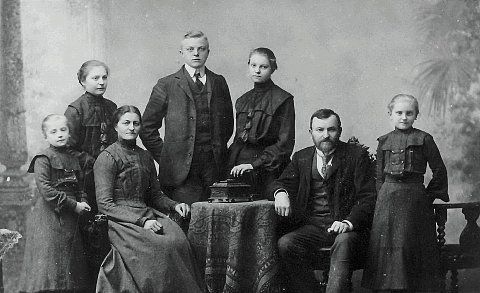-
Y-DNA37 & mtDNA Plus
review on 12 March 2014
by Craig Macpherson

At a Glance
Summary
Overall, I'd say Family Tree DNA is a fantastic tool for genealogy enthusiasts. It may be a bit too advanced for some beginners but there are lots of tutorial and help sections in the online account if you need them.
In terms of buying their test through The Genealogist, it’s worth bearing in mind that going to Family Tree DNA direct will cost you less if you don’t mind paying in US dollars.
Full Review
The Genealogist website listed several types of DNA test: Y-DNA tests for paternal ancestry, mtDNA tests for maternal ancestry, and an autosomal DNA test to analyse my recent ancestral mix. Depending on the type of test I purchased, I'd be given access to the world's largest genealogy database to help trace my living relatives.
There were five levels of depth available for paternal tests and two for maternal tests. Tests of greater depth cost extra but would analyse more genetic markers, improving the breadth and accuracy of my search for living relatives. The website was really easy to use and there was a helpful table that outlined all the combination packages you could buy at a discount.
I chose the Y-DNA37 + mtDNAPlus combination test which would report on both my paternal and maternal ancestry.
Product Expectations
According to The Genealogist, this test would allow me to trace my living relatives – aka my matches – where we shared a common ancestor within eight generations on my paternal line, and within 28 generations on my maternal line. It's a shame there weren't any examples of the results on the site as this would have helped manage my expectations.
Ordering Experience
During the order process I tried to use PayPal but the page didn’t work correctly so I had to use a debit card instead. After purchasing the test I received an email from Family Tree DNA, thanking me for ordering through ‘S&N Genealogy Services’. I thought this was a little odd and was no longer sure which company would be processing my test.
Seven working days later a Family Tree DNA testing kit arrived. The instructions were easy to follow but I was disappointed that I had to pay £3 to post the kit back to the US. I received confirmation that my samples had reached the lab within three weeks of sending them off.
The Results
Seven weeks later my paternal Y-DNA and maternal mtDNA results were ready in the Family Tree DNA online account. There were more than a dozen areas to explore when I logged in, each with tutorials and help sections to help me make sense of the results.
Results Section: Paternal Haplogroup
My 'paternal haplogroup' was predicted as ‘R-P312’ and upon clicking this result, a paragraph described the migratory path of my paternal ancestors. It's a shame that the term 'haplogroup' hadn't been explained by this point as the information would have been a bit more meaningful to me. I was also shown a ‘haplotree’ (shown below) which depicted the haplogroups most closely related to mine.
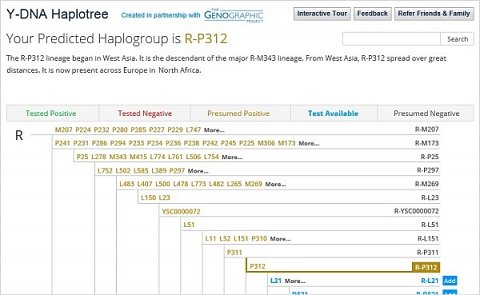
The location of my predicted haplogroup on the Y-DNA haplotree.
Results Section: Maternal Haplogroup
‘H’ was shown to be my 'maternal haplogroup' and upon clicking this result, I was given an overview of the migratory path of my maternal ancestors.
This section also contained a grid showing ‘RSRS’ and ‘rCRS’ values, and these indicated how my mtDNA differed to that of the earliest common maternal ancestor we all share.
Results Section: Paternal and Maternal Migration Maps
Interactive maps were available which showed my paternal and maternal ancestors’ migratory paths from Africa into Europe - my maternal migration map is shown below.
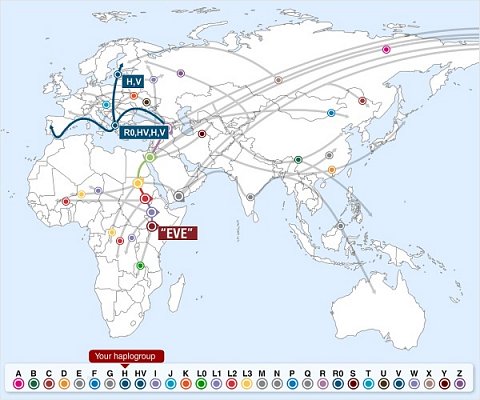
The maternal haplogroup migration map.
This gave me a fascinating glimpse of the journey that my ancestors made over tens of thousands of years, and let me compare it to the ancestral migratory paths of other haplogroups.
Results Section: Paternal Matches
There were 'matches' sections in the account which listed the living relatives I shared paternal and maternal ancestry with. For paternal matches I had no living relatives at 37 Y-DNA markers, two at 25, and 1,530 at 12! The FAQ told me that the number of markers I shared with a living relative was linked to how far back we shared a common ancestor. Matches at more markers meant our common ancestor lived fewer generations ago. My Y-DNA matches at 25 markers are shown below.

My Y-DNA matches at 25 markers.
Results Section: Maternal Matches
For maternal matches, I had 412 living relatives according to the ‘HVR1’ and ‘HVR2’ regions of my mtDNA, and 2,384 according to the HVR1 region only. The FAQ said that living relatives matched at both HVR regions were done so at a greater confidence level than at just one. Contact details were listed alongside each match so I could get in touch.
The ancestors I shared with my living relatives were also shown, sometimes by name, and it was interesting to see when and where they'd lived.
Results Section: Ancestral Origins
One of the sections was titled 'Ancestral Origins' and showed which countries my living relatives were from using maps and tables. My maternal matches map (according to the HVR2 region of my mtDNA) is shown below.
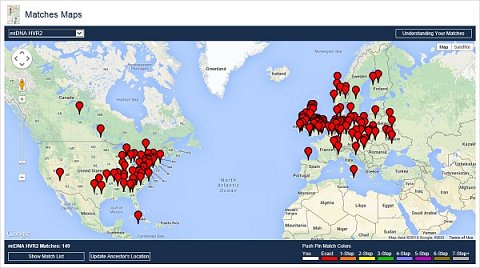
My mtDNA HVR2 matches map.
One of the paternal tables (shown below) revealed that at ‘genetic distance -1’, 4.9% of my paternal matches lived in England, 7.7% in Wales, and 5.8% in France! I wasn't aware of any Welsh or French relatives on my father's side of the family.
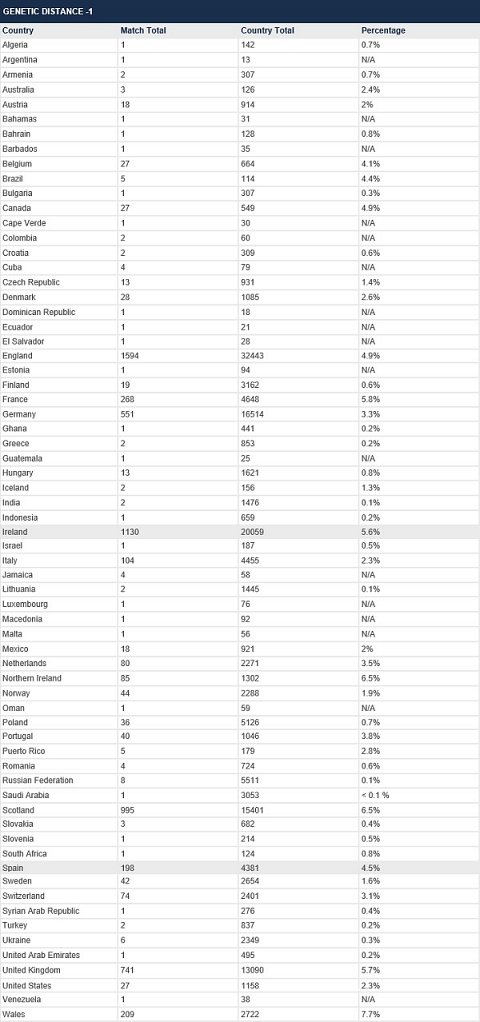
My paternal ancestral origins matches at genetic distance -1.
The paternal data also revealed that at 12 Y-DNA markers; 3% of my living relatives were from Australia, more than from anywhere else! The maternal data showed that at HVR1 level; 3.4% of my living relatives were from Greece, 2.4% from Germany, and only 2.2% from England. This was surprising as I was expecting my mother's side of the family to have the most matches in England, and don't believe we have any Greek relations.
Summary
Overall, I'd say Family Tree DNA is a fantastic tool for genealogy enthusiasts. It may be a bit too advanced for some beginners but there are lots of tutorial and help sections in the online account if you need them.
In terms of buying their test through The Genealogist, it’s worth bearing in mind that going to Family Tree DNA direct will cost you less if you don’t mind paying in US dollars.
Visit The Genealogist to learn more about this DNA testing service >

